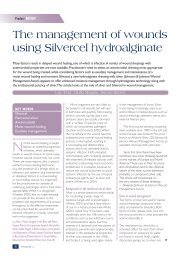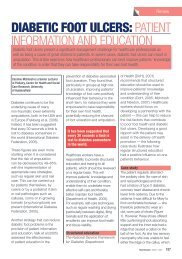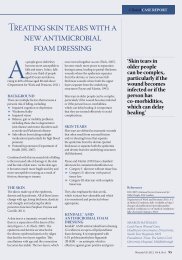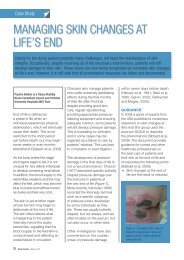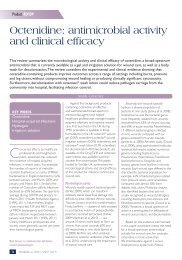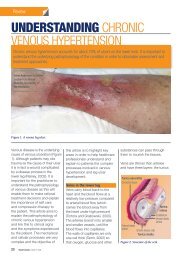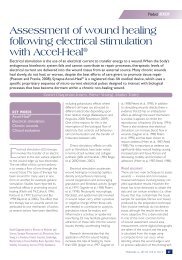VIEW PDF - Wounds UK
VIEW PDF - Wounds UK
VIEW PDF - Wounds UK
You also want an ePaper? Increase the reach of your titles
YUMPU automatically turns print PDFs into web optimized ePapers that Google loves.
Clinical RE<strong>VIEW</strong><br />
Barrier products and<br />
their purpose<br />
Barrier products have become a staple part of skin care<br />
regimens and, consequently, there are a wide range<br />
available. This article aims to provide an understanding of<br />
various barrier products, explaining the need for barrier<br />
protection, when to use these products, and how to select<br />
and apply the most appropriate barrier products.<br />
“At present, several<br />
types of barrier<br />
product are available.<br />
However, such a wide<br />
selection of products<br />
can prove confusing<br />
for the user, which can<br />
lead to inappropriate<br />
use and poor skin<br />
care.”<br />
MENNA LLOYD JONES<br />
Independent Tissue Viability Nurse<br />
48 Wound Essentials 2013, Vol 8 No 1<br />
Good skin care is an important<br />
aspect of general patient<br />
care. Skin damage following<br />
exposure to excessive moisture,<br />
including urine, faeces, and wound<br />
exudate, is not an uncommon<br />
problem. Using appropriate measures<br />
to protect vulnerable skin and prevent<br />
skin breakdown is an essential<br />
element of patient care (Best Practice<br />
Statement [BPS], 2012). For many<br />
years, barrier products have been<br />
used in an attempt to protect the<br />
skin from moisture damage (Voegeli,<br />
2013).<br />
At present, several types of barrier<br />
product are available. However, such a<br />
wide selection of products can prove<br />
confusing for the user, which can lead<br />
to inappropriate use and poor skin<br />
care.<br />
Protecting the skin’s integrity from the<br />
harmful effects of excessive moisture<br />
is a common challenge faced by<br />
clinicians (Voegeli, 2007). There are<br />
several factors, such as incontinence,<br />
excessive perspiration, and wound<br />
exudate, that can put the patient at<br />
increased risk of skin damage from<br />
prolonged exposure to moisture.<br />
Gray et al (2011) used the term<br />
“moisture-associated skin damage”<br />
(MASD) to describe the damage<br />
caused by prolonged exposure<br />
to moisture. They also explained<br />
that MASD is characterised by<br />
inflammation of the skin, occurring<br />
with or without erosion, or secondary<br />
cutaneous infection.<br />
Some of the most common forms<br />
of MASD include incontinenceassociated<br />
dermatitis, periwound<br />
moisture-associated dermatitis,<br />
and peristomal moisture-associated<br />
dermatitis (Gray et al, 2011).<br />
Barrier function of the skin<br />
The skin is the largest organ of the body<br />
covering approximately 2m 2 or 3 000 2<br />
inches and constitutes almost onesixth<br />
of total body weight. The skin<br />
receives around one-third of the body’s<br />
circulating blood volume (Tortora and<br />
Anagnostakos, 1990). It is made up of<br />
two main layers: The epidermis and<br />
the dermis. Lying beneath the dermis<br />
is the subcutaneous layer (also called<br />
the superficial fascia or hypodermis;<br />
Timmons, 2006). The skin has a pH of<br />
between 4 and 5.5 creating an acidic<br />
mantle that protects the body from<br />
certain bacteria and fungi (Newton<br />
and Cameron, 2003).<br />
The epidermis is the thin, outermost<br />
layer of the skin and has a thickness
Clinical RE<strong>VIEW</strong><br />
of between 0.5 mm and 4.0 mm<br />
(BPS, 2012). It is made up of cells<br />
called keratinocytes, which are<br />
formed in the lower layer of the<br />
epidermis (the stratum basale),<br />
and gradually migrate through the<br />
layers to the epidermis (the stratum<br />
corneum). The stratum corneum is<br />
made up of tightly packed, flattened<br />
cells called corneocytes, which are<br />
held together by a lipid-rich matrix<br />
(Voegeli, 2013).<br />
The epidermis acts as a physical<br />
barrier between the external<br />
environment and the body’s internal<br />
environment. When intact, it<br />
prevents the entry of pathogenic<br />
“In clinical practice<br />
there is often confusion<br />
between barrier products<br />
and emollients, with<br />
the terms ‘barrier’ and<br />
‘emollients’ often being<br />
used interchangeably.”<br />
organisms, minimises the absorption<br />
of harmful substances, contains<br />
a mix of substances that actively<br />
attract and hold water in the<br />
cernocytes, and prevents excessive<br />
water loss from the body (Voegeli,<br />
2010; 2013).<br />
Persistent exposure to moisture<br />
from, for example urine, faeces, and<br />
exudate, can cause over hydration<br />
of the skin. Over-hydration,<br />
particularly of the stratum corneum,<br />
can precipitate inflammation by<br />
facilitating the passage of irritants<br />
into the skin, resulting in dermatitis.<br />
The role of barrier products<br />
Barrier products are used as part<br />
of routine skin care regimens to<br />
protect the skin from damage<br />
caused by excessive contact with<br />
moisture. However, in clinical<br />
practice there is often confusion<br />
between barrier products and<br />
emollients, with the terms “barrier”<br />
and “emollients” often being used<br />
interchangeably (Voegeli, 2007).<br />
Barrier products – as the name<br />
suggests – are designed to protect<br />
the skin by minimising its exposure<br />
to excessive moisture. Emollients<br />
are lipid emulsions used to sooth<br />
and hydrate the skin. They work<br />
by occluding the skin surface and<br />
reducing the amount of water loss<br />
through the stratum corneum<br />
(Voegeli, 2010). Although some<br />
barrier products may have a mild<br />
hydrating properties, they are not<br />
emollients and should not be used<br />
as such. Similarly, emollients should<br />
not be used to protect the skin from<br />
damage by excessive moisture.<br />
Barrier products were traditionally<br />
creams consisting of a lipid–water<br />
emulsion base with the addition<br />
of metal oxides, such as zinc or<br />
titanium (Voegeli, 2010). The<br />
product was applied as a thin layer<br />
on the skin. Disadvantages of these<br />
barrier creams were their propensity<br />
to “clog” continence products<br />
and prevent dressing adherence<br />
(Voegeli, 2007). However, the<br />
clogging of incontinence products<br />
was probably due to the excessive<br />
use of cream and not the cream per<br />
se, according to the manufacturer’s<br />
instructions (Bolton, 2004). Another<br />
issue arising from traditional barrier<br />
products is the potential of some of<br />
the ingredients to cause an allergic<br />
reaction in some individuals (e.g.<br />
zinc, castor oil containing arachis<br />
[peanut] oil).<br />
A variety of new, synthetic, siliconebased,<br />
non-irritant barrier products<br />
are now available. These products<br />
provide a thin, protective polymer<br />
film and are available as creams,<br />
films, and wipes (Voegeli, 2008).<br />
The advantages of silicone products<br />
is that they dry without leaving a<br />
residue, and are not petroleumbased<br />
and should, therefore, not<br />
Glossary<br />
Excoriation: Inflammation of the<br />
epidermis as a result of chemical<br />
disruption of the stratum<br />
corneum due to an irritant for<br />
example bodily fluids (Hampton<br />
and Stephen-Haynes 2005).<br />
Excoriation often occurs in the<br />
presence of maceration and<br />
again results in skin trauma<br />
(Collins et al, 2002).<br />
Maceration: Occurs when the<br />
tissue becomes white and<br />
soggy in appearance and is less<br />
resilient (Collins et al, 2002).<br />
Peristomal skin: The skin<br />
surrounding a stoma.<br />
Periwound skin: The skin<br />
surrounding a wound.<br />
interfere with the adhesion of<br />
dressings (Cutting, 2006). Also, they<br />
do not sting on application.<br />
The ideal barrier product should<br />
be suitable for use on both intact<br />
and broken skin. It should also be<br />
hypoallergenic, transparent, easy to<br />
apply, breathable, have protective<br />
properties, and be pain free to<br />
the user (Voegeli, 2008; Flynn and<br />
Williams, 2011).<br />
Using barrier products in<br />
clinical practice<br />
The fundamental care of any<br />
patient with MASD is based on<br />
keeping the skin clean and using<br />
a barrier product (Voegeli, 2013).<br />
Prior to applying any product to<br />
the skin, it is important to assess<br />
the patient and ensure the product<br />
selected is appropriate for their<br />
needs. It is important to read the<br />
product information and follow<br />
the manufacturer’s instructions<br />
(Beldon, 2008).<br />
The clinician should explain the<br />
procedure to the patient, gain their<br />
consent, and ensure they are made<br />
50 Wound Essentials 2013, Vol 8 No 1
Clinical RE<strong>VIEW</strong><br />
as comfortable and safe as possible<br />
during treatment (Penzer, 2009).<br />
When undertaking skin care, all<br />
equipment required should be<br />
gathered and prepared. This may<br />
include any cleansing products,<br />
gloves and aprons, dressings,<br />
continence products, clean linen,<br />
and the appropriate barrier product<br />
(Penzer, 2009).<br />
Barrier products should always be<br />
applied to clean skin. Therefore,<br />
prior to application, the skin should<br />
be cleansed using a non-soap foam<br />
cleanser as soap and water can<br />
change the pH of the skin from<br />
acidic to alkaline which, in turn,<br />
can lead to dryness and cracking<br />
(BPS, 2012).<br />
Barrier products and the<br />
incontinent patient<br />
The optimal skincare regimen for<br />
the person with incontinence is<br />
to cleanse the skin following each<br />
episode of incontinence, using a<br />
non-soap cleanser as mentioned<br />
above. Following cleansing, a<br />
suitable barrier product should be<br />
applied to protect the skin from<br />
further damage. If incontinence<br />
products are used, the clinician<br />
should ensure the barrier product<br />
selected is compatible with the<br />
incontinence products (Voegeli,<br />
2013).<br />
Barrier creams are designed for<br />
use on intact skin and should not<br />
be applied to broken skin unless<br />
specified in the manufacturer’s<br />
instructions. Barrier films are<br />
suitable for use on both broken<br />
and unbroken skin (Voegeli, 2007;<br />
Beldon, 2008).<br />
not a diagnosis, and full assessment<br />
is required to ascertain the<br />
cause of the incontinence so that<br />
preventative measures can be put in<br />
place (BPS, 2012).<br />
Barrier products for<br />
wound exudate<br />
Exudate is a necessary component<br />
in the wound healing process.<br />
However, excessive exudate can<br />
damage the periwound skin and<br />
cause the wound to deteriorate.<br />
Application of an appropriate<br />
“The skin should be<br />
cleansed using a nonsoap<br />
foam cleanser as<br />
soap and water can<br />
change the pH of the skin<br />
from acidic to alkaline<br />
which, in turn, can lead<br />
to dryness and cracking.”<br />
barrier product can help protect<br />
the periwound skin.<br />
However, it is also vital to identify<br />
and address the cause of the<br />
excessive exudate (World Union of<br />
Wound Healing Societies, 2007).<br />
The type of barrier product<br />
selected is again dependent on<br />
the findings of the initial patient<br />
assessment, which should include<br />
the condition of the surrounding<br />
skin and wound size. Barrier<br />
film applicators may aid the<br />
application of the film to small-tomedium-sized<br />
wounds. For large<br />
wounds, film spray is available.<br />
Always allow the product to dry<br />
completely before applying any<br />
pads or clothing as they may<br />
stick. Clinicians must check<br />
the manufacturer’s instructions<br />
to determine the frequency of<br />
reapplication; some barrier films<br />
only require reapplication after 72<br />
hours.<br />
Barrier products for<br />
peristomal skin<br />
Barrier products are not always<br />
appropriate in the care of<br />
peristomal or broken skin (Figure<br />
1). However, when they are<br />
required silicone-based barrier<br />
wipes are usually the most<br />
appropriate modality. These wipes<br />
are designed to be used under<br />
adhesive stoma products. Patients<br />
often manage their own stoma and<br />
they report that barrier wipes are<br />
easier to use and make adhesion of<br />
the appliance easier than traditional<br />
barrier creams (Voegeli, 2008;<br />
Burch, 2011).<br />
If there is server excoriation of<br />
the skin then active measures<br />
to contain urine and/or faeces,<br />
and protect the skin may also be<br />
required (BPS, 2012; Voegeli, 2013).<br />
The clinician should bear in mind<br />
that incontinence is a symptom and<br />
Figure 1. An example of the inappropriate use of a traditional barrier<br />
cream on broken skin.<br />
52 Wound Essentials 2013, Vol 8 No 1
Clinical RE<strong>VIEW</strong><br />
Conclusion<br />
Protecting the skin from excessive<br />
moisture is a common challenge<br />
faced by clincians today. There are<br />
a range silicone-based products<br />
available that are easy to apply and<br />
skin-friendly, and are available as<br />
creams, films, and wipes.<br />
Barrier products should be used<br />
as part of a holistic skin care<br />
regimen designed to protect<br />
against excess moisture exposure. A<br />
barrier product should be selected<br />
following a holistic assessment of<br />
the patient. The manufacturers’<br />
instructions should be read and<br />
followed.<br />
Further assessment of the patient<br />
will be required to determine the<br />
cause of the excessive moisture and<br />
other interventions maybe needed<br />
to treat the problem. WE<br />
References<br />
Beldon P (2008) Moisture lesions:<br />
The effect of urine and faeces on<br />
the skin. Wound Essentials 3: 82–7<br />
Best Practice Statement (2012)<br />
Care of the Older Person’s Skin (2 nd<br />
edn). <strong>Wounds</strong> <strong>UK</strong>, London<br />
Bolton C (2004) Assessment of pad<br />
clogging. Journal of Community<br />
Nursing 18(6): 18–20<br />
Burch J (2011) Peristomal skin<br />
care and the use of accessories<br />
to promote skin health. Br J Nurs<br />
20(7): S4–S10<br />
Collins F, Hampton S, White R<br />
(2002) The A–Z Dictionary of<br />
Wound Care. Quay Books, London<br />
Cutting KF (2006) Silicone and skin<br />
adhesives. Journal of Community<br />
Nursing 20(11): 36–8<br />
Flynn D, Williams S (2011) Barrier<br />
creams for skin breakdown. Nursing<br />
54 Wound Essentials 2013, Vol 8 No 1<br />
and Residential Care 13(11): 553–8<br />
Gray M, Black JM, Baharestani MM<br />
et al (2011) Moisture-associated<br />
skin damage: overview and<br />
pathophysiology. J Wound Ostomy<br />
Continence Nurs 38(3): 233–41<br />
Hampton S, Stephen-Haynes<br />
J (2005) Skin maceration:<br />
assessment, prevention and<br />
treatment. In: Skin Care in Wound<br />
Management: Assessment,<br />
Prevention and Treatment.<br />
<strong>Wounds</strong> <strong>UK</strong>, Aberdeen<br />
Newton H, Cameron J (2003)<br />
Skin Care in Wound Management.<br />
Medical Communications Ltd,<br />
Holsworthy<br />
Penzer R (2008) Best practice when<br />
applying topical barrier creams.<br />
Wound Essentials 4: 75–7<br />
Timmons J (2006) Skin function<br />
and healing. Wound Essentials 1: 18<br />
Tortora GJ, Anagnostakos NP<br />
(1990) The Principles of Anatomy<br />
and Physiology (6th edn).<br />
HarperCollins, London<br />
Voegeli D (2007) Factors that<br />
exacerbate skin breakdown and<br />
ulceration. In: Skin Breakdown. The<br />
Silent Epidemic. Smith & Nephew<br />
Foundation, Hull<br />
Voegeli D (2008) LBF® ‘no-sting’<br />
barrier wipes: skin care using<br />
advanced silicone technology.<br />
Br J Nurs 17(7): 472–6<br />
Voegeli D (2010) Care or harm:<br />
exploring essential components<br />
in skin care regimens. Br J Nurs<br />
19(13): 810–4<br />
Voegeli D (2013) Moistureassociated<br />
skin damage: and<br />
overview for community nurses.<br />
Br J Comm Nurs 18(1): 6–12<br />
World Union of Wound Healing<br />
Societies (2007) Principles of Best<br />
Practice. Wound Exudate and the<br />
Role of Dressings. A Consensus<br />
Document. MEP Ltd, London



